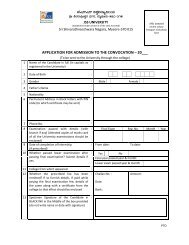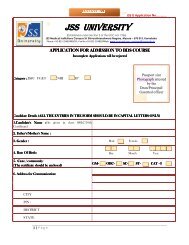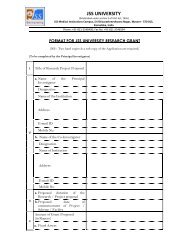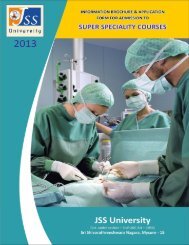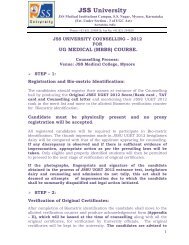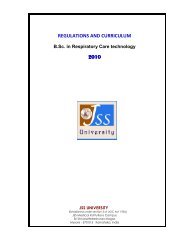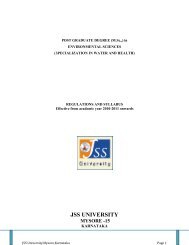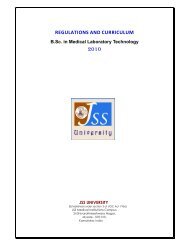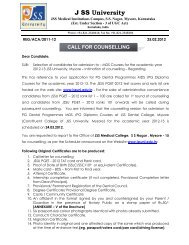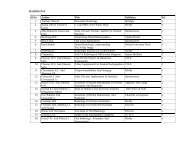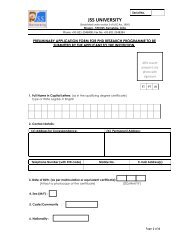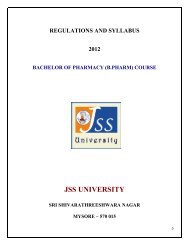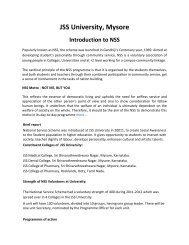to view / download - Isolation - JSS University, Mysore
to view / download - Isolation - JSS University, Mysore
to view / download - Isolation - JSS University, Mysore
Create successful ePaper yourself
Turn your PDF publications into a flip-book with our unique Google optimized e-Paper software.
By - Dr. Kanupriya Choudhary<br />
MDS 1 st year<br />
Dept.of Paedodontic and<br />
Preventive Dentistry<br />
<strong>JSS</strong>DCH, <strong>Mysore</strong><br />
1
ISOLATION<br />
A technique <strong>to</strong> protect a <strong>to</strong>oth against<br />
contamination from oral fluids during a surgical<br />
or res<strong>to</strong>rative procedure, usually through the<br />
application of a rubber dam or various other<br />
measures.<br />
2
CONTENT<br />
Objective of isolation<br />
Need for isolation in pediatric dentistry<br />
Methods for isolation<br />
Direct method Indirect method Drugs<br />
•Advantages<br />
•Disadvantages<br />
Summary<br />
References<br />
Rubber Dam<br />
Other direct method<br />
•Indication<br />
•Contraindication<br />
•Precaution<br />
•Armamentarium<br />
•Sterilization<br />
•Preparation, Placement & Removal<br />
of rubber dam<br />
•Radiographic techniques<br />
•Alternative methods<br />
•Variation with age<br />
•Error in application & removal<br />
•Recent advances<br />
3
OBJECTIVES OF ISOLATION<br />
Dry field<br />
Access and visibility<br />
Patient protection<br />
To improve operating efficiency<br />
It is essential that there should be proper moisture<br />
control , good accessibility and visibility as well as<br />
adequate room for instrumentation around the working<br />
area . Such an environment is necessary for easy<br />
manipulation and insertion of res<strong>to</strong>rative materials.<br />
4
METHODS FOR ISOLATION<br />
- Direct methods<br />
- Indirect methods<br />
Rubber dam<br />
Cot<strong>to</strong>n rolls and cot<strong>to</strong>n<br />
roll holder<br />
Gauze pieces<br />
Absorbent wafers<br />
Suction devices<br />
Gingival retraction cord<br />
Mouth props<br />
Comfortable position of<br />
patient and relaxed<br />
surroundings<br />
Local anesthesia<br />
Drugs :- Anti – sialogogues,<br />
Anti anxiety , Muscle<br />
relaxants<br />
5
DIRECT METHOD<br />
RUBBER DAM<br />
Rubber dam provides the best possible<br />
isolation by far.<br />
The Rubber Dam is a flat , thin sheet of latex or<br />
non latex that is held by a clamp (retainer) and a<br />
frame that is perforated <strong>to</strong> allow the teeth that<br />
will be worked on <strong>to</strong> protrude through the<br />
perforations in the sheet while all the other teeth<br />
are covered and protected by the rubber dam.<br />
It is used <strong>to</strong> define the operating field by isolating<br />
one or more teeth from oral environment.<br />
6
ADVANTAGES<br />
Improvement of access.<br />
Retraction and protection of soft tissues.<br />
Provision of a dry operating field.<br />
Improve visibility.<br />
Provision of an aseptic environment.<br />
Prevention of ingestion and inhalation of foreign<br />
bodies.<br />
Aid <strong>to</strong> patient management.<br />
Aid <strong>to</strong> cross-infection control by reducing aerosol<br />
spread of micro-organisms.<br />
Minimization of mouth breathing during inhalation<br />
sedation procedure.<br />
KENNEDY<br />
7
DISADVANTAGES<br />
Time consuming.<br />
Patient’s objection.<br />
Trauma <strong>to</strong> marginal gingiva.<br />
Trauma <strong>to</strong> cementum<br />
Poorly retentive clamps.<br />
Metal crown margins show microscopic defect<br />
following clamp removal.<br />
Ceramic crowns may fracture at the margins if<br />
clamp is allowed <strong>to</strong> grip the porcelain<br />
8
INDICATION<br />
The use of the dam is indicated in virtually all (99.9%)<br />
cases.<br />
Certainly rubber dam is indicated in all operative<br />
procedures and endodontics.<br />
When using high copper amalgam , as it is influenced<br />
by moisture contamination.<br />
It has been used in diagnosis <strong>to</strong> isolate teeth for<br />
thermal test and interdentally during electric pulp<br />
testing.<br />
In periodontal therapy as an aid in root planing and in<br />
combination with a periodontal pack as a dressing<br />
following flap surgery.<br />
9
CONTAINDICATION<br />
In the presence of some fixed orthodontic appliances.<br />
Partially erupted <strong>to</strong>oth can’t receive a retainer.<br />
Some third molars.<br />
Children suffering from asthma , some upper<br />
respira<strong>to</strong>ry infections or mouth breathing problems.<br />
Cannot be used in case of extremely malpositioned<br />
teeth.<br />
Latex allergy.<br />
Psychological in<strong>to</strong>lerance.<br />
Patient at risk with transient bacteremia.<br />
Severe gingival disease.<br />
10
PRECAUTIONS<br />
The rubber dam should not obstruct patient’s airway<br />
and thus should not cover his nose.<br />
Holes should be prepared in rubber dam for<br />
patients with upper respira<strong>to</strong>ry tract obstruction.<br />
On patients with allergy <strong>to</strong> latex , latex free rubber<br />
dam should be used. Rubber dam napkin can be<br />
used <strong>to</strong> prevent the latex rubber dam from<br />
contacting the patient’s tissues.<br />
11
ARMAMENTARIUM<br />
Rubber dam sheets<br />
Rubber dam clamps or retainers<br />
Rubber dam holder (frame)<br />
Rubber dam retaining forceps<br />
Rubber dam punch<br />
Rubber dam templates or stamps<br />
Dental floss<br />
Napkin<br />
Wooden wedges , orthodontic elastics &<br />
commercially available latex cord.<br />
Lubricant<br />
Modelling compound<br />
Scissors<br />
STUDERVANTS<br />
12
RUBBER DAM SHEETS<br />
• Size – 5×5 inch ( 12.5 12.5 cm )<br />
6×6 inch ( 15 15 cm )<br />
• Thickness – Thin - 0.15 mm (0.006 inch)<br />
Medium - 0.20 mm (0.008 inch)<br />
Heavy - 0.25 mm (0.010 inch)<br />
Extra heavy - 0.30 mm (0.012 inch)<br />
Special heavy - 0.35 mm (0.014 inch)<br />
• Colors - green , blue , black , pink and burgundy<br />
Darker color offers better visual contrast.<br />
• Flavors – mint , banana and strawberry<br />
• It has shiny and dull surface. Dull surface is kept<br />
facing occlusally since it is less reflective.<br />
13
RUBBER DAM CLAMPS OR RETAINERS<br />
• Used <strong>to</strong> secure the dam <strong>to</strong> the teeth<br />
that are <strong>to</strong> be isolated & <strong>to</strong> minimally<br />
retract the gingival tissue.<br />
• Parts - 4 prongs that rest on the mesial and distal<br />
line angle of the <strong>to</strong>oth and 2 jaws connected by a<br />
bow.<br />
• If extended beyond the mesial and distal line angles<br />
of <strong>to</strong>oth –<br />
- Interfere with matrix and wedge placement<br />
- gingival trauma is more likely <strong>to</strong> occur<br />
- a complete seal around the anchor <strong>to</strong>oth is more<br />
difficult <strong>to</strong> achieve.<br />
14
Types :<br />
Continued…<br />
Winged<br />
Wingless<br />
Serrated<br />
Clamp with jaws inclined cervically <strong>to</strong> engage<br />
erupting <strong>to</strong>oth or severely broken down teeth.<br />
Clamps with endo – illumina<strong>to</strong>r system <strong>to</strong><br />
illuminate pulp chamber and canal orifices.<br />
Winged<br />
Wingless<br />
15
RUBBER DAM HOLDERS (FRAME)<br />
• Used <strong>to</strong> maintain the borders of the rubber dam in<br />
position.<br />
• The frame is U shaped and could be an adult or<br />
pedodontic , one made of metal or plastic.<br />
• Types – 1) Metallic ( Young’s frame ) – Holder of a wire<br />
2 mm in diameter. Application is easy and<br />
comfortable. Can be easily used in child<br />
patient.<br />
`<br />
2) Plastic ( Nygaard ostby frame , Starlite<br />
visiframe , Le Cadre Articule , quick dam ) –<br />
Useful when a radiograph is <strong>to</strong> be taken<br />
without removing the frame.<br />
16
Young’s Frame<br />
Nygaard Ostby Frame<br />
Starlite Visiframe<br />
Le Cadre Articule Rubber Dam Frame<br />
Handidam<br />
Optra Dam<br />
Instidam<br />
Dry Dam<br />
17
RUBBER DAM RETAINING FORCEPS<br />
STOKES<br />
BREWER<br />
ASH type<br />
It is a forcep that holds the retainer and facilitates its<br />
placements and removal from the <strong>to</strong>oth.<br />
18
RUBBER DAM PUNCH<br />
It is a precision instrument having a rotating metal<br />
table ( disk ) with six holes of varying sizes and a<br />
tapered , sharp – pointed plunger.<br />
Use the smaller holes for the incisors , canines and<br />
premolars and the larger holes for the molars. The<br />
largest holes is generally reserved for the posterior<br />
19<br />
anchor <strong>to</strong>oth.
RUBBER DAM TEMPLATES OR STAMPS<br />
Both have positions of the teeth marked on them and are<br />
used <strong>to</strong> transfer them <strong>to</strong> the rubber dam sheet for holes <strong>to</strong><br />
be punched.<br />
20
STERILIZATION<br />
The rubber dam sheet itself with the rubber dam<br />
napkin and any floss or wedges used are disposable<br />
and so do not require sterilization.<br />
The rubber dam frame , clamps and clamp forceps<br />
must be carefully cleaned and sterilized between<br />
patients , preferably in an au<strong>to</strong>clave.<br />
The rubber dam punch should not need <strong>to</strong> be<br />
sterilized frequently , since it only contact the rubber<br />
dam before it is placed in the patient’s mouth.<br />
Punches are made with carbon steel components<br />
therefore hot air sterilization should be used.<br />
Reid,Callis,Patterson<br />
21
PREPARATION OF THE RUBBER DAM<br />
Three stages are involved :<br />
Stage-1 : SELECTION OF THE DAM<br />
Heavy and extra heavy dams are used for res<strong>to</strong>rative<br />
procedures while medium is considered ideal for<br />
endodontic purposes since it:<br />
- retracts the tissues better than thin type<br />
- is easier <strong>to</strong> place than heavier type.<br />
The natural or translucent rubber dam has advantages<br />
for endodontic radiography with the dam in place.<br />
Reid,Callis,Patterson<br />
22
Stage-2 : MARKING THE HOLES<br />
Punch an identification hole in the upper left corner of the<br />
rubber dam for ease of location of that corner when applying<br />
the dam <strong>to</strong> the holder.<br />
<strong>Isolation</strong> of a minimum of three<br />
teeth is recommended except<br />
when endodontic therapy is<br />
indicated , and in that case only<br />
the teeth <strong>to</strong> be treated is<br />
isolated.<br />
The distance between the holes<br />
is equal <strong>to</strong> the distance from<br />
the centre of one <strong>to</strong>oth <strong>to</strong> the<br />
centre of the adjacent <strong>to</strong>oth ,<br />
measured at the level of the<br />
gingival tissue. This is<br />
approximately ¼ inch (6.3mm).<br />
Studervants<br />
23
Stage-3 : POSITION OF THE HOLES<br />
Single <strong>to</strong>oth isolation<br />
• It should be near the centre of the rubber sheet within<br />
the area of the sheet corresponding <strong>to</strong> the quadrant<br />
under treatment.<br />
• It is recommended that the <strong>to</strong>p edge of the rubber<br />
sheet is positioned <strong>to</strong> lie above the lip of the patient<br />
during endodontic procedures.<br />
Multiple <strong>to</strong>oth isolation<br />
•If the dental arch is regular , a rubber stamp or<br />
template can be used <strong>to</strong> indicate the positions of the<br />
holes.<br />
• Templates are designed <strong>to</strong> be placed behind the rubber<br />
dam and the <strong>to</strong>oth positions marked with a pen. 24
PLACEMENT OF RUBBER DAM<br />
Three methods<br />
1. Dam first technique<br />
2. Clamp first technique<br />
3. Clamp and dam <strong>to</strong>gether technique<br />
KENNEDY<br />
25
REMOVAL OF THE RUBBER DAM<br />
Cutting the septa<br />
Removing the retainer<br />
Removing the dam<br />
Wiping the lips<br />
Rinsing the mouth<br />
Massaging the tissue and<br />
Examining the dam<br />
STUDERVANTS<br />
26
RADIOGRAPHIC TECHNIQUES<br />
Normal radiographic techniques , particularly film<br />
positions have <strong>to</strong> be modified when the rubber dam<br />
frames and clamps are in place.<br />
Metal rubber dam frames are best avoided<br />
Varients on the bisecting angle techniques are used<br />
• The simplest method is <strong>to</strong> remove the frame and<br />
place the film as close as possible <strong>to</strong> the <strong>to</strong>oth.<br />
• Use haemostats <strong>to</strong> hold the film for the short cone<br />
bisecting angle technique. Frame removal is not<br />
required.<br />
• Tongue spatulas can be used in place of haemostats<br />
advantage of being disposable and radiolucent.<br />
• Simple plastic film holder ‘Rinn Eezee Grip’ can be<br />
used.<br />
Reid,Callis,Patterson<br />
27
ALTERNATIVE METHODS<br />
Cervical retainer replacement<br />
Fixed bridge isolation<br />
Substitution of retainer with a matrix<br />
STUDERVANTS<br />
28
VARIATIONS WITH AGE<br />
For younger - change the hole size<br />
- smaller sheet<br />
Primary teeth- HF no.27 retainer<br />
isolation is usually from the most posterior <strong>to</strong>oth <strong>to</strong><br />
the canine on the same side.<br />
Young permanent teeth – Ivory no. 14<br />
The jaws of the retainers used on primary and young<br />
permanent teeth need <strong>to</strong> be directed more gingivally<br />
because of short clinical crowns or because the anchor<br />
<strong>to</strong>oth’s height of con<strong>to</strong>ur is below the crest of gingival<br />
tissue.<br />
STUDERVANTS<br />
29
SLIT-DAM METHOD<br />
Rubber dam use in primary dentition is simplified by<br />
the slit-dam method.<br />
Rather than punching multiple <strong>to</strong>oth holes in the<br />
dam and isolating each <strong>to</strong>oth in the quadrant , three<br />
large holes are punched out 1-2 cm apart and are<br />
joined by a scissors cut.<br />
Such rubber dam application is rapid (5-10 sec) and<br />
the desired teeth are completely available for<br />
res<strong>to</strong>rative treatment<br />
DCNA ,39 -4 , OCT 1995<br />
30
ERRORS IN APPLICATIONS AND REMOVAL<br />
Errors - Prevent adequate moisture control<br />
Reduce access and visibility<br />
Cause injury <strong>to</strong> patient<br />
Different types of errors-<br />
<br />
<br />
<br />
<br />
<br />
<br />
Off centre arch form<br />
Inappropriate distance between holes<br />
Incorrect arch form of holes<br />
Inappropriate retainer<br />
Shredded or <strong>to</strong>rn Dam<br />
Sharp tips of no 212 retainer<br />
STUDERVANTS<br />
31
RECENT ADVANCES<br />
Hat Dam :<br />
Cushioning Metal Clamp Jaw<br />
Liquid Dam / Opal Dam<br />
Cushees<br />
Fiber Optic Clamps<br />
32
OTHER DIRECT METHOD<br />
COTTON ROLLS<br />
GAUZE PIECES<br />
ABSORBENT PADS/WAFERS<br />
RETRACTION CORD<br />
MOUTH PROPS
SUCTION DEVICES<br />
High Volume Vacuum<br />
Saliva Ejec<strong>to</strong>r<br />
Svedopter<br />
Isolite system<br />
34
INDIRECT METHOD<br />
DRUGS<br />
Rarely indicated in res<strong>to</strong>rative dentistry.<br />
Atropine (antisialogogues) -5mg , 30min before the<br />
procedures - reduce salivation<br />
Antianxiety drugs like valium - 5 <strong>to</strong> 10mg 30min before.<br />
Muscle relaxants.<br />
Medication for controlling gingival bleeding.<br />
Pain control medication.<br />
Contraindication - nursing mothers and Glaucoma<br />
patients.<br />
35
SUMMARY<br />
A thorough knowledge of isolation reduces the physical<br />
strain on the dental team associated with daily dental<br />
treatment , reduces patient anxiety associated with dental<br />
procedures , and enhances moisture control , thereby<br />
improving the quality of operative dentistry.<br />
36
REFERENCES<br />
Paediatric operative dentistry-KENNEDY<br />
Pediatric dentistry – Pinkham<br />
Dentistry for child and adolescent - McDonald<br />
Art and science of operative dentistry-Studervants<br />
Rubber dam in clinical practice - Reid, Callis, Patterson<br />
Pediatric dentistry , 2010;32-1, Jan-Feb<br />
DCNA , 1995; 39-4, Oct<br />
Fundamental of pediatric dentistry - Mathewson<br />
Internet<br />
37



